| Home -> Other California History Books -> Tour of the Governor of Pennsylvania Members of His Staff and the Pennsylvania Panama-Pacific Exposition Commission - Text | |||
 |
|||
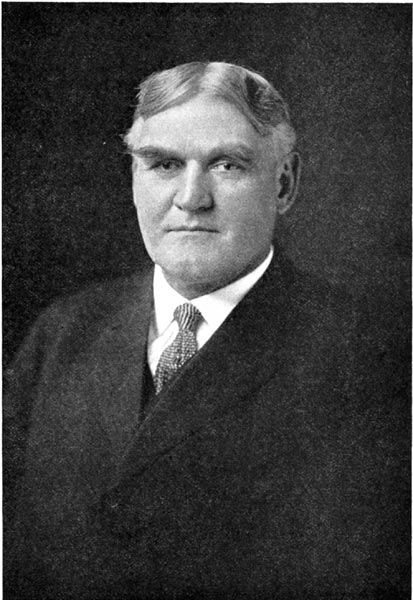 Hon. Martin G. Brumbaugh Governor of Pennsylvania |
|||
|
Tour of the Governor of Pennsylvania
Members of His Staff And the Pennsylvania Panama-Pacific Exposition Commission For the Celebration of Pennsylvania Day Saturday, September 4, 1915 At the Panama-Pacific International Exposition San Francisco, Cal. Arranged by the Pennsylvania Railroad Pennsylvania Panama-Pacific Exposition Commission Members Hon. Martin G. Brumbaugh, President Hon. Frank B. McClain E. L. Tustin Thos. S. Crago Charles W. Sones James L. Adams H. J. Heinz M. S. Hershey Francis Shunk Brown George W. Creighton Charles F. Thompson, Treasurer Charles A. Bentley C. Victor Johnson Charles A. Shaffer Ernest T. Trigg Charles D. Armstrong Morgan E. Gable G. W. Nitrauer E. H. Porter Charles A. Woods Chester P. Ray C. E. Carothers, Secretary Executive Committee E. L. Tustin, Chairman Francis Shunk Brown Thos. S. Crago C. V. Johnson G. W. Nitrauer Ernest T. Trigg Chester P. Ray M. S. Hershey H. J. Heinz James S. Hiatt, Secretary Chester P. Ray - Executive Officer and Director in Charge of Industrial Exhibits A. O. Hetherington - Director in Charge of Building, Education and Arts |
|||
| Pennsylvania's Beautiful Building at the Panama-Pacific International Exposition That Pennsylvania, Keystone in the arch of the thirteen original states, Birthplace of the Declaration of Independence, and Home of the Liberty Bell, may be suitably represented in the country's celebration of the completion of the great Panama Canal, a tour of the Governor of the Commonwealth, members of his staff, and the Pennsylvania Panama-Pacific Exposition Commission, to San Francisco to participate in the exercises of Pennsylvania Day, Saturday, September 4, at the Panama-Pacific International Exposition, has been arranged. At the request of the Pennsylvania Panama-Pacific Commission, the Pennsylvania Railroad has provided a special train, of all-steel equipment, for the exclusive use of the party, which is being operated under the direction of its Personally-Conducted Tours System in accordance with the following itinerary. An experienced representative of the railroad accompanies the party throughout the tour to see that every detail of the trip is carried out. A Special Baggage Master, and a Stenographer, who will render free service, are also on the Special Train. Baggage will be available in baggage car at any time during the trip. The mecca of every loyal Pennsylvanian who visits the Exposition at San Francisco is the Pennsylvania Building, one of the most ornate buildings ever erected by the State at an International Exposition, and, as the temporary resting place of the Liberty Bell, one of the most visited of the Exposition buildings. On the Avenue of the Commonwealths, midway between the buildings erected by New York State, New York City, New Jersey and the Argentine Republic, Pennsylvania's shrine, in simple, yet beautiful Colonial architecture, stands out typical of the sturdy spirit of the forefathers of the Republic whose proud boast it is that they have linked the oceans betwixt two continents of the Western Hemisphere. One thinks instinctively of Independence Hall when gazing upon the building, although there is only a suggestion of the Hall in its form and the dignified roof which covers its colonnaded loggia, wherein rests the Liberty Bell. Flanked by two wings, this lofty and spacious loggia, opening on each side through tall, slender colonnades to the terraces that give access to the building, rises in stately form to California's blue sky. Capped by a gabled roof, in imitation of that upon Independence Hall and other pure types of the Colonial school, surmounted by delicate balustrades, and with great pierced chimneys on either end, topping a solid structure of brick in Colonial bond, this stately hall well represents the solid, sterling qualities of the Keystone State. Opening from the loggia, doors lead on either side to wings which still further carry out the Colonial idea in architecture, with brick and white wood structure. Each is but one story in height, the roof surmounted by a balustrade similar to that upon the loggia, and with the narrow-paned windows, so familiar in homes that have stood since the early days. The eastern wing contains a reception room, octagonal in form, with slender pilasters supporting the vaulted roof that leads to the skylight above. Around this extends a frieze of paintings by Charles J. Taylor, of Pittsburgh. Passages lead from this reception hall to rest rooms for men and for women and to various offices. The western wing is taken up by an assembly hall in which are shown moving pictures of historical events, educational institutions and industrial activities. Paintings by Edward Trumbull, one typifying the steel industry, and the other Penn's Treaty with the Indians, are hung on opposing facades of east and west buildings. The Colonial idea is still further carried out in the use of white enamelled woodwork throughout the buildings. This State Building was dedicated with appropriate ceremonies on March 18, 1915, by Hon. John K. Tener, representing Hon. Martin G. Brumbaugh, Governor of Pennsylvania, and the following members of the Commission: Hon. E. L. Tustin, Chester P. Ray, James L. Adams, George W. Creighton and Charles F. Thompson. Through the courtesy of James Bellak's Sons, a Style XVI Victrola will be placed in the observation car for the enjoyment of the party. |
|||
|
"So, sons of no mean Commonwealth, we come
From Eastern Portals to the Western gate; As those of old who cried 'Romanus sum,' So we exultant speak the name of State, Proclaim the great 'experiment' that wrought As if by necromance 'mong doubting men, Fruition sure! Harvest beyond all thought, Yet hidden in the very heart of Penn! And bear the message, flash it sea to sea, Who freedom serve must of themselves be free !" From Dedication Poem by Harvey Maitland Watts. Itinery |
|||
| Miles from Philadelphia |
Monday, August 23, 1915 Pennsylvania Railroad |
||
| 0 Lv. | Philadelphia, Pa. (Broad Street Station) The main line of the Pennsylvania Railroad presents a beautiful panorama of varied scenery. The wonderfully-developed suburban section, followed by the pastoral beauty of the Chester and Pequea valleys, and the wide-spread farm lands of Lancaster county, is a fitting overture to the marvels of Nature to be seen in a trans-continental tour. |
1.00 PM | |
| 104 Ar. | Harrisburg, Pa. | 3.30 PM | |
| Lv. | Harrisburg, Pa. In the shadow of the Blue Mountains, just beyond Harrisburg, the crossing of the Susquehanna River over the Rockville Bridge, the longest and widest stone-arch bridge in the world, marks the beginning of a trip which will be found full of delightful experiences. Beyond the bridge, the route follows the course of the Juniata River through the mountains for over one hundred miles. |
3.37 PM | |
|
135 Ar.
|
Altoona, Pa. |
6.37 PM
|
|
|
Lv.
|
Altoona, Pa. Dinner in dining car. |
6.42 PM | |
|
240 Pass
|
Horseshoe Curve This famous piece of railroad engineering always attracts the attention of travelers by the Pennsylvania Railroad. The railroad, after leaving Altoona station, which lies 1179 feet above sea level, winds around and up the side of the main ridge to Kittanning Point, ascending 423 feet in about five miles. The curve itself is a little over 1845 feet in length, and the view from the center of it down the valley is superb. The up-grade to the tunnels at Galitzin is a steady one, an average of about 85 feet to the mile. The line enters the tunnel at the summit over 1000 feet above the level of the Altoona station. The gorge of Allegrippus, passed just before the tunnel is reached, is one of the wildest regions in the state. Beyond, in the early evening, the winding course of the Conemaugh is followed, past Johnstown, to Blairsville Intersection, whence the railroad turns over the hills, past coke furnaces and busy manufacturing plants, to Pittsburgh. |
about 7.00 PM |
|
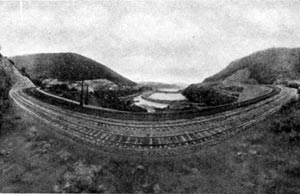 |
|||
|
349 Ar.
|
Pittsburgh, Pa. (Eastern Time) Pennsylvania Lines |
9.40 PM | |
|
Lv.
|
Pittsburgh, Pa. (Central Time) Leaving Pittsburgh, the party will travel directly to Chicago over the Fort Wayne Route, following the Ohio River for some miles and then turning across the states of Ohio and Indiana during the hours of darkness. |
9.00 PM | |
|
Tuesday, August 24
Breakfast in dining car. |
|||
|
817 Ar.
|
Chicago, Ill. (Union Station) The party will spend the daylight hours in sightseeing in Chicago. Luncheon will he taken at individual expense. The City of Chicago is the most important railroad center in the United States, thirty of the largest lines operating over 2000 trains in and out of the city each day. Laid out as a city in 1830, when there were but one hundred persons residing there, it developed rapidly as emigration westward progressed in the early days of the Republic. Today it is one of the leading business and banking centers in the world, controlling practically all of the business of the Middle West. Almost destroyed by fire in 1871, it is now a city of magnificent distances, with wide boulevards intersecting its principal streets, and a park system that is the admiration of all lovers of decorative horticulture and floriculture. Chicago & Northwestern Railway |
9.00 AM | |
|
Lv.
|
Chicago, Ill. (Chicago and Northwestern Station) Dinner in dining car. During the night the Special Train crosses the states of Illinois and Iowa to the Missouri River valley at Omaha, passing over the giant Mississippi River just east of Clinton, Iowa, This is a wonderful farming country. |
6.05 PM | |
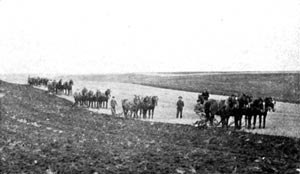 The Limitless Plains 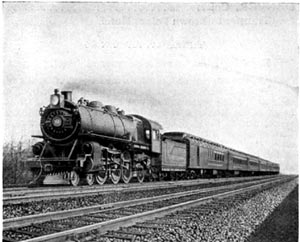 The Special Train En Route |
|||
|
Wednesday, August 25
Breakfast, luncheon and dinner in dining car. |
|||
|
1305 Ar.
|
Omaha, Neb. Situated in the very heart of the great corn and wheat belt of the United States, Omaha is the metropolis of Nebraska and shares with Kansas City the trade of the great Missouri valley and plains country between the Missouri and the Rocky Mountains. It has an area of a little over 24 square miles and is the third largest live stock and packing center in the world. Union Pacific Railroad |
7.20 AM | |
|
Lv.
|
Omaha, Neb. Leaving Omaha for the trip to Denver, one's mind will turn back to the days of '49, for the route of the Special Train enters on that long trail across the plains followed by the thousands who journeyed in prairie schooner, on horse back and afoot in the quest for the gold of California's mountains. |
7.35 AM | |
|
1596 Ar.
|
North Platte, Neb. (Central Time) | 2.15 PM | |
|
Lv.
|
North Platte, Neb. (Mountain Time) West of North Platte, one really begins the climb upward from the Mississippi valley into the heart of the Rockies, although it has been a steady upgrade all the way from Omaha. The railroad skirts the course of the south Branch of the Platte River almost to its source on the slopes of the mountains. From Julesburg, the first station in Colorado, to Denver, one ascends nearly 2000 feet in less than 200 miles. Within a few hours after passing this point the summits of Rampart Range of the Rockies begin to show on the western horizon, and the last forty miles of the trip into Denver lies almost the foot of these outposts of the mountains, with Long's and Gray's Peaks cleaving the blue Colorado sky. |
1.20 PM | |
|
1874 Ar.
|
Denver, Col. Transfer to Brown Palace Hotel. |
9.30 PM | |
|
Thursday, August 26
Breakfast, luncheon and dinner at hotel. |
|||
| Denver, the capital of Colorado, and the metropolis of the Rocky Mountain region, lies on a plateau, over a mile above sea level and eleven miles east of the front range of the Rockies. It has an area of fifty-nine square miles, and is divided by the South Platte River and Cherry Creek into four sections, commonly referred to as "sides." The population is about 245,000, composed of the best citizens from all parts of the United States. It was first settled in 1858, and was named for General James W. Denver, then Governor of Kansas Territory. In addition to well-built business places and fine homes on wide streets, Denver boasts a number of public buildings that are worthy of note. The Auditorium, first used for the Democratic National Convention of 1908; City Hall, Federal Building, U. S. Mint, and University of Denver are among the more prominent. One may obtain a fine view of the mountains from Inspiration Point in Berkeley Park, or take one of the wonderful one-day side trips from Denver to Silver Plume or Corona. The Special Train will be placed in the station ready for occupancy on Thursday evening, August 26th, at 10.00 PM. Transfer from Brown Palace Hotel to train. |
|||
|
Friday, August 27
Denver & Rio Grande Railroad |
|||
|
Lv.
|
Denver, Col. During the night the Special Train turns southward along the eastern front of the range to the foot of Pikes Peak, the southern sentinel of the Rampart group of mountains. |
3.00 AM | |
|
1949 Ar.
|
Colorado Springs, Col. Breakfast in dining car. Auto ride from train to Garden of the Gods and Manitou, returning to Antlers Hotel for luncheon. After luncheon leave hotel 1.00 PM for auto trip to Crystal Park, returning to hotel for dinner. Colorado Springs, the leading health resort of Colorado, is visited every year by thousands on account of the climate and beautiful scenic surroundings. There is much to be seen at this highly-developed health and pleasure resort, which lies among the hills that cling closely to the steeps of Pikes Peak, whose snow-crowned summit is in sight from all parts of the city. One may ascend this giant of the Rockies on the cog wheel railroad that extends from Manitou to the summit, 14,157 feet above sea level. One of the interesting side trips from Colorado Springs is the automobile ride to Crystal Park, Comfortable cars leave Colorado Springs and roll over a specially constructed road which winds up the side of the mountain in great curves, gradually ascending over sixteen hundred feet to Eagle's Nest. The views along the road are wonderful, embracing many miles of country. Five miles west of Colorado Springs, under the frowning shadow of Pikes Peak is Manitou, one of the greatest resort places on the American continent. Here is the famous "Garden of the Gods," whose stately walls, gateways, cathedral spires, and monumental figures have been the wonder of all who have seen them. The Special Train will be placed in the station ready for occupancy at 10.00 PM. Transfer from Antlers Hotel to train. |
6.00 AM | |
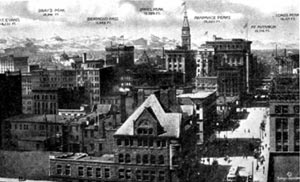 Denver, Colorado 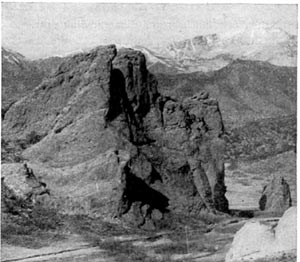 Garden of the Gods and Pike's Peak |
|||
|
Saturday, August 28
Breakfast, luncheon and dinner in dining car. |
|||
|
Lv.
|
Colorado Springs, Col. Swinging southward, the Special Train continues along the westward, border of the Colorado plain to Pueblo, (known as the Pittsburgh of the West, from its many smelters and steel plants). Turning sharply to the west, the railroad passes through Florence, the heart of the Colorado oil fields, and Canyon City, a great orchard center, and plunges into the depths of the Grand Canyon of the Arkansas. |
3.00 AM | |
|
2039 Pass
|
Royal Gorge Here is the narrowest portion of the canyon. The red granite and gneiss walls tower upward 2667 feet; and the narrow strip of sky appears like a blue-gray ribbon in which stars may be seen at midday. At one point, the Hanging Bridge, the gorge is but ten yards wide. Beyond the Royal Gorge, the canyon widens out, until, in the upper valley of the river beyond Salida, a broad prospect of ranchland is in view, with the Collegiate Range on the left, and Mt. Massive, the highest peak in the state (14,424 feet) ahead. Along toward midday, still following the Arkansas, now but a creek, the Special Train begins the ascent of the Continental Divide through Tennessee Pass. The crest of the divide is pierced by a half-mile-long tunnel. During the afternoon and early evening, the varied beauties of Red Cliff, Eagle River and Grand River canyons pass in review. Beyond Grand junction, the party will surmount the slope of the Utah mountains during the the night and come down into the valley of the Jordan and Salt Lake City in the early morning. |
about 7.00 AM |
|
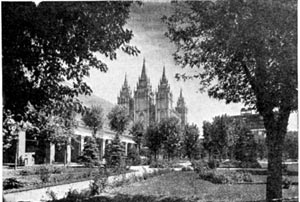 Mormon Temple and Tabernacle, Salt Lake City |
|||
|
Sunday, August 29
|
|||
|
2620 Ar.
|
Salt Lake City, Utah Breakfast in dining car. Side trip by train to Saltair Beach on Great Salt Lake in the morning. Luncheon at Hotel Utah. Special services at Mormon Tabernacle at 2.00 pm. Auto sight-seeing trip to points of interest after services. Salt Lake City is situated in the great valley of the Jordan, west of the Wasatch mountains, and just fifteen miles south of the Great Salt Lake. The City is beautifully laid out and possesses numerous public buildings of note. On Oil Creek, immediately where it emerges from the range, are the grounds and offices of the Presidency of the Mormon Church. Separated from these by East Temple (Main Street) is Temple Block, the very heart of the Mormon world, where sit the turtle-roofed Tabernacle, and the white granite walls and towers of the Temple. On the same blocks are the Endowment House and Assembly Hall, both buildings connected with the worship of the Mormons. The great Temple, which was begun in 1853 and completed in 1893 at a cost of $4,000,000, is a most imposing place of worship, which is unique in that no admission can be had to it except by those in membership of the Mormon Church. The Tabernacle, which is open to the public and is used for regular religious services by the Mormons, seats 13,456 people and contains the second largest organ in the world. Aside from its position as the headquarters for the Mormons, Salt Lake City is noted as a remarkably clean and pretty city, with a fine supply of mountain water which is inexhaustible and a number of interesting sights for the tourist. A trip will be made to Saltair Beach on the Great Salt Lake, the largest body of inland salt water in the world. |
8.00 AM | |
|
Lv.
|
Salt Lake City, Utah Dinner in dining car. Between Salt Lake City and Ogden, the route lies through picturesque ranches, To the east lie the summits of the Wasatch Range, and to the west a glimpse is caught of Great Salt Lake, that wonderful inland sea, lying 4200 feet above the oceans, and which has no apparent outlet. |
6.00 PM | |
|
2657 Ar.
|
Ogden, Utah (Mountain Time) | 7.00 PM | |
|
Southern Pacific Company
|
|||
|
Lv.
|
Ogden, Utah (Pacific Time) Shortly after leaving Ogden, the route leads out over the waters of Great Salt Lake by the wonderful Salt Lake Cut-off, built to save many miles of traveling around the northern end of the lake. This is like going to sea in a train, for the tracks touch land only once in crossing the lake, a distance of 42 miles. Beyond comes the salt desert, whose snowy whiteness is dazzling to the eye, and Nevada's long stretches of sand, sage brush and serrated mountain ranges, most of which is passed through during the night. |
6.15 PM | |
|
Monday, August 30
Breakfast, luncheon and dinner in dining car. |
|||
| In the morning, the rocky heights of the Sierra Nevada fill the western horizon. Passing the crest of the range the descent to the Pacific slope is made away up on the side of the beautiful canyon of the American river. At Blue Canyon, and again at Cape Horn, with the river twisting and turning in the depths, 2000 feet below the tracks, the vista across the gorge is magnificent. Thence through orchard-checkered foothills, Sacramento, the capital City of the state is reached. At Benicia, about thirty miles from San Francisco, the entire train is ferried across Carquinez Strait to Port Costa; the line thence skirting the eastern shore of San Francisco Bay to Oakland Pier. | |||
|
Ar.
|
Oakland Pier, Cal. Here the Special train is left and a trans-bay steamer carries the party to the great ferry station at the foot of Market Street, San Francisco. |
7.30 PM | |
|
3439 Ar.
|
San Francisco, Cal. Passengers and baggage will be transferred to the Palace Hotel for the stay in San Francisco. |
8.00 PM | |
|
Tuesday, August 31 to Saturday, September 4
In San Francisco. Visit the Panama-Pacific International Exposition and other points of interest. Saturday, September 4 Pennsylvania Day Special Program 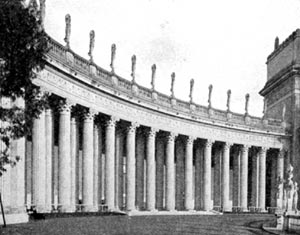 Colonnade Transportation Palace San Francisco |
|||
|
San Francisco, with a population of half a million, is the nucleus of a metropolitan district made up of a cluster of cities about the bay, whose combined population exceeds three-quarters of a million. It is one of the most interesting cities on the Pacific Coast for the tourist on account of the cosmopolitan character of its population, and the many attractive side trips that may he made in a short time from the city. This "City of a Hundred Hills" is situated between the bay and the Pacific Ocean, on a bold promontory at the southern side of the mile-wide straits forming the world-famed "Golden Gate." Its business section, all new since the earthquake, is filled with fine buildings, handling the commerce of the world; palatial hotels, pretty theatres, and attractive restaurants. Back from the water front the city sweeps op the sides of the steep hills, and here one finds a residential section that is unsurpassed anywhere for beauty of buildings and gardens. The marine and surrounding shore line and mountain views to be obtained from the many vantage points on these hills cannot be equaled anywhere. There are thirty-two parks. Golden Gate Park (1013 acres) is one of the most beautiful and remarkable public reservations in the world. It contains a chain of artificial lakes, massive bridges, children's playgrounds, and sections devoted to sports of all kinds, a Japanese tea Garden, an historical museum and art gallery, a herd of buffalo and a herd of deer, in addition to wonderful floriculture. Just beyond Golden Gate Park is the Cliff House, overlooking Seal Rocks, where the sea lions sun themselves. Then there is the Presidio, a United States Military Reservation of 1542 acres adjoining the Exposition Grounds, Sutro Heights Italian Gardens (open to the public), the country club, and other parks. Chinatown, with its 10,000 Celestial inhabitants, its gay bazaars and their gorgeous offerings from which to select mementoes for relatives and friends, its street scenes with native men and women in their quaint costumes, is like a vista from the Orient. |
|||
|
The Panama-Pacific International Exposition
|
|||
| The grounds of the Panama-Pacific International Exposition spread out along the bay shore where it is just beginning to narrow into the Golden Gate. In perfect keeping with the thought that San Francisco is the gate to the Orient, the character of the buildings and their decorations have been made oriental in character and coloring. The climate of California lends itself particularly to the development of such a scheme of color effect in architecture and horticulture as has been carried out in the Exposition. Millions of blooms of every shade and hue, blend with the myriad colors of the artist on court and tower, on building and statuary until the whole ensemble glows like a rainbow. There are eight principal exposition palaces, in one of which (The Transportation Palace) the Pennsylvania System has installed an exhibit of models and a moving picture theatre showing views of the entire system. The Tower of Jewels, 430 feet high, glistening with jewels brought to this country from Austria before the war, dominates the whole scene. The Court of the Sun and Stars and the Court of Abundance, the Alameda and the Marina, fronting the main group of buildings of the city and bay sides, are wonderful examples of landscape gardening. The various states have erected buildings in which are shown matters distinctively local to the state, and several of the foreign governments are represented by separate buildings. The amusement concessions form what is known as "The Zone," and pessimistic, indeed, is he or she who cannot find some amusement here. This section is open at night as well as the grounds surrounding the palaces; the latter is closed to the public at sundown. |
|||
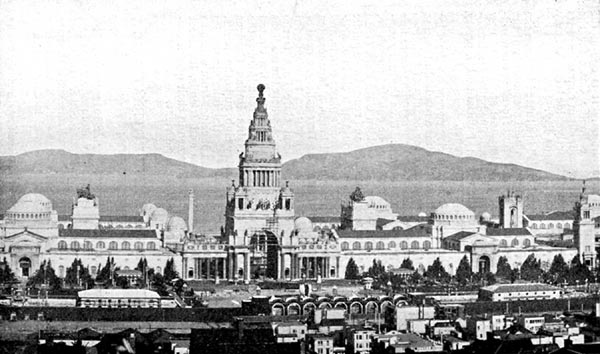 Panama-Pacific Exposition, San Francisco |
|||
|
Homeward Bound
Sunday, September 5 Transfer from Palace Hotel to station. |
|||
| Miles from San Francisco |
Southern Pacific Company
|
||
|
0 Lv.
|
San Francisco, Cal. | 8.00 AM | |
|
4 Lv.
|
Oakland Pier, Cal. Luncheon and dinner in dining car. Leaving Oakland Pier, the Special Train runs over the same route as on the going journey as far as Sacramento. Beyond is the fertile valley of the Sacramento River, with its many ranches on both sides of the railroad. To the east are the Sierra Nevada Mountains and as one goes further and further up the Sacramento valley, the slopes of the Coast Range come into view on the west. Between Red Bluff, 225 miles north of San Francisco, and Redding, Mt. Lassen, California's active volcano, is in sight on the east, distant about forty-five miles. |
8.30 AM | |
|
325 Ar.
|
Shasta Springs, Cal. A half hour stop will be made at Shasta Springs, at the foot of Mt. Shasta for a taste of the wonderful Shasta water and a sight of the glories of Shasta Canyon. Leaving the Springs, and climbing out of the Canyon, the majesty of Mt. Shasta comes full into view. This giant of the Pacific Coast has a total elevation of 14,380 feet and rises almost precipitously from the surrounding plateau for a height of over 11,000 feet. There are five glaciers on the mountain and it is snow-tipped during the greater part of the year. |
7.30 PM | |
|
Lv.
|
Shasta Springs, Cal. During the night the train speeds up and over the Siskiyou Range, bordering California's northern line. |
8.00 PM | |
|
Monday, September 6
Breakfast and luncheon in dining car. |
|||
| Early morning will find the party amid the fertile farms and orchards of Oregon in the Rogue, Umpqua and Willamette River valleys. For some time before reaching Portland, the snowtipped peak of Mt. Hood will he seen to the northeast, always a picturesque factor in a visit to the country around Portland. | |||
|
771 Ar.
|
Portland, Ore. Visit points of interest. Dinner at Hotel Benson. Transfer to Station. Beautifully situated at the confluence of the Willamette and Columbia, Portland is one of the most important commercial centers on the Pacific Coast, not only as a manufacturing point, but as an exporting and importing port in the trade with Japan, China and the far East. The city slopes west from the river to a range of hills from whose slopes and summits may be had a magnificent view of the city, valley, river, and mountain range, with four eternal snow peaks standing out in bold relief and varying in height from 10,000 to 15,000 feet above sea level. Looking to the north, Mt. Rainier, 14,363 feet high, peeps above the horizon, white and dazzling; a little to the right, but near at hand, rises the beautiful white cone of Mt. St. Helens, 10,000 feet in height; farther away again and to the northeast rises in its great white, monumental grandeur Mt. Adams, 12,470 feet high; to the east, and sixty miles distant, but seemingly in the clear atmosphere, nearer six miles away, stands Mt. Hood, the peculiar joy and glory of Oregonians, 11,225 feet high, with its glaciers and snow fields. Northern Pacific Railway |
1.00 PM | |
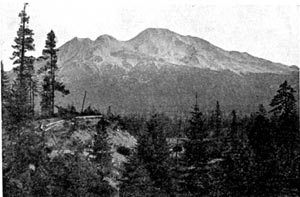 Mt. Shasta, California |
|||
|
Lv.
|
Portland, Ore. | 12.00 NT | |
|
Tuesday, September 7
Breakfast in dining car. |
|||
| During the night the Special Train will cross the Columbia River and continue up the coast to Puget Sound. Early risers will find Mt. Rainier (called Mt. Tacoma when viewed from Tacoma) standing majestic to the east and a distant glimpse of Mt. Adams, may be had if the day be bright. | |||
|
953 Ar.
|
Seattle, Wash. Transfer to Hotel Washington for luncheon. Visit points of interest. Seattle, which had its beginning not so many years ago as a lumber camp, is situated on Elliott Bay of Puget Sound. To the west, across the Sound, the Olympic Range of mountains shows its white crested battlements. To the southeast, the hoary head and glacier-coated sides of Rainier shuts in the view. To the northeast the summit of Mt. Baker, the most northern of the Cascade Range giants just shows above the horizon on clear days. Seattle has 300 churches, the Washington State University and a Public Library, containing 125,000 volumes, and does an enormous export and import business, particularly, with Alaska and the far East. The census of 1910 gave it 327,194 population and it is growing fast every year. Transfer to Station. |
9.00 AM | |
|
Lv.
|
Seattle, Wash. Dinner in dining car. The trip from Seattle to Spokane is full of surprises. Soon after leaving Puget Sound, the railroad begins the ascent of the Cascade Range, a grand stretch of mountains, black with timber from the bottom of the deep gulches to the tops of the divides and peaks. The crossing of the range is made through Stampede Tunnel, two miles long and 2852 feet above sea level. During the night the valleys of the Yakima, Kittitas and Columbia Rivers and the plains between the Cascade and Bitter Root Mountains are traversed. |
6.00 PM | |
|
Wednesday, September 8
Breakfast, luncheon and dinner in dining car. |
|||
|
1332 Ar.
|
Spokane, Wash. Visit points of interest. Spokane is a city of much influence and wealth, with a population approximating 110,000. It is the business center of Coeur d'Alene, Republic and other mining districts and a broad and very rich agricultural section. The city is well built and there is $50,000,000 invested in industrial plants in the immediate vicinity. Electric power is generated by the picturesque Spokane Falls, right in the heart of the city. |
8.05 AM | |
|
Lv.
|
Spokane, Wash., (Pacific Time) Eastward from Spokane, the route leads between the Cabinet and Coeur d'Alene Ranges of the Rockies, past beautiful Pend d'Oreille Lake; a little stream, known variously as Pend d'Oreille, Clark Ford, Missoula, Hell Gate, Deer Lodge and Silver Bow River, and through the northern ranges of the American Rockies. |
11.30 AM | |
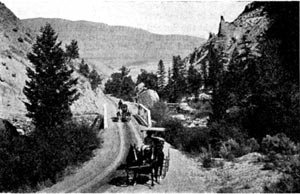 Gardiner Canyon, Yellowstone Park |
|||
|
Thursday, September 9
Breakfast in dining car. |
|||
|
1903 Ar.
|
Gardiner, Mont. (Mountain Time) Gardiner is the northern entrance to the Yellowstone National Park. Here the party leave the Special Train for the trip through the Park by stage. Yellowstone Park Transportation Company |
7.00 AM | |
|
Lv.
|
Gardiner, Mont. Yellowstone National Park is the greatest natural exposition in the world. Here Nature has outdone herself in providing wonderful sights for the visitor. The United States Government which has set apart this district as a reservation under the care of a superintendent, has developed a fine system of roadways and trails through the Park, so that practically every point of interest is within easy access. Taking stages at Gardiner Station, the party begin the first lap of the tour through the canyon of the Gardiner River. Almost at the station, Boiling River, a subterranean stream through which the waters of Mammoth Hot Springs empty into the Gardiner, is the first evidence of the wonderful geysers beyond. As one passes on through the canyon, the grim shadow of Electric Peak, whose snow-capped head rises 11,150 feet above the Park level, is cast over the valley. |
7.00 AM | |
|
1908 Ar.
|
Mammoth Hot Springs, Wyo. | 8.00 AM | |
|
Lv.
|
Mammoth Hot Springs, Wyo. Without pausing for sight-seeing here, the party proceed on the second lap of the journey, passing on up the valley of the Gardiner River, past the Golden Gate and through Kingman Pass. Twelve miles from Mammoth Hot Springs is a curious volcanic formation, Obsidian Cliff, lying just beyond Apollinaris Spring. This is a two hundred feet high cliff of natural glass, black as ink and rising in columns from the road, which itself is made out of the glass. After passing Obsidian Cliff and skirting the base of Roaring Mountain, the stage enters the Norris Basin, the most northern of the geyser basins in the Park, and supposedly the most recent in geologic formation. |
8.15 AM | |
|
1928 Ar.
|
Norris, Wyo. Luncheon at hotel. Here will be found the Monarch, a very irregular geyser, but when in action, forcing the hottest of water to a height varying from one hundred to two hundred and forty feet. The Hurricane and Black Growler are prodigious steam geysers whose continuous roar may be heard a distance of four miles. |
12.15 NN | |
|
Lv.
|
Norris, Wyo. Leaving Norris luncheon station, the stages start along the canyon of the Gibbon River, a tributary of the Madison - the latter one of the headwaters of the Missouri: Coming out of the canyon beyond Gibbon Falls, the party catch their first glimpse of the Teton Mountains, fifty miles away to the south, which mark the most wonderful group of river sources upon the earth. Here within a radius of about one hundred miles rise the Missouri, Yellowstone, Wind, Big Horn, Platte, the tributaries of the Colorado, and the Snake. Winding down from the plateau above the Gibbon to the canyon of the Firehole River, the route soon lies within the Lower Basin of the Firehole group, where the great natural phenomena are seen at their best, and a stop is made at Fountain Hotel in the heart of this region for the night. |
1.45 PM | |
|
1948 Ar.
|
Fountain Hotel, Wyo. Dinner and lodging at hotel. |
5.30 PM | |
|
Friday, September 10
Breakfast at hotel. |
|||
|
Lv.
|
Fountain Hotel, Wyo. In the morning, the Fountain Geyser, one of the best spouters in the region; the Mammoth Paint Pots, most remarkable example of bright colored muds, and the Firehole, a large hot spring in which burns a light colored flame of natural gas, are seen, and the tour of the Park continued to Old Faithful Inn, in the Upper Geyser Basin. Prismatic Lake, upon whose mist covered surface is displayed every color of the rainbow: Biscuit Basin and Morning Glory Pool are passed in rapid succession as the stages bring the party into the Upper Basin. |
8.30 AM | |
|
1957 Ar.
|
Upper Geyser Basin, Wyo. Locate at Old Faithful Inn for luncheon, dinner and lodging. Here is the true home of the genius geyser. Around Old Faithful Inn are fifteen examples of the first magnitude, besides scores of lesser ones, and nearly all active. Here are the Riverside, Grotto, Splendid, Giant, Castle, Lion, Giantess, Punch Bowl and Bee Hive, in addition to Old Faithful, whose hourly performances always insure visitors to the Park a sight of a geyser in action. Its vertical column of water, one hundred and fifty feet high, springing out of the treeless plain, ejects over thirty million gallons of water daily, so it is estimated. |
10.30 AM | |
|
Saturday, September 11
Breakfast at hotel. |
|||
|
Lv.
|
Upper Geyser Basin, Wyo. The third day in the Park takes the party over the Continental Divide, the road lying for a distance of about ten miles on the Pacific slope. Two Ocean Lake on the Divide, feeds the Missouri River through Spring Creek and the Firehole and Madison Rivers, and the Columbia River through Shoshone Lake, Lewis Lake and the Lewis and Snake Rivers, thus affording a continuous waterway between the Atlantic and the Pacific Oceans. Shoshone Lake, a beautiful body of water with the Tetons for a background, may be seen from Shoshone Point, and then the road leads back over the Divide to the Atlantic side. In a few minutes, Yellowstone Lake, lies spread out three hundred feet below the road. |
7.30 AM | |
|
1976 Ar.
|
Thumb (Yellowstone Lake) Wyo. Luncheon at hotel. Yellowstone Lake is nearly a mile and a half above the level of the sea, or a quarter of a mile higher than Mt. Washington. It has an area of one hundred thirty-nine square miles and a maximum depth of three hundred feet. At one point upon its shore fish may be caught and cooked in the boiling spring without taking them from the line. |
11.30 AM | |
|
Lv.
|
Thumb (Yellowstone Lake), Wyo. The trip to Lake Hotel, at the mouth of the Lake in Yellowstone River, may be made by launch across the lake. The stages continue along the northern edge of the lake, with the dark background of the Absaroka Mountains on the eastern horizon. |
1.15 PM | |
|
1992 Ar.
|
Lake Hotel, Wyo. Dinner and lodging at hotel. |
4.00 PM | |
|
Sunday, September 12
Breakfast at hotel. |
|||
|
Lv.
|
Lake Hotel, Wyo. The day, next the stages take the party through the Hayden Valley, following the Yellowstone after it leaves the Lake, past Elephant Back and Sulphur Mountains and the Mud Geyser. As the Upper Falls are neared the road becomes decidedly picturesque. At one point it is hung upon the side of an almost perpendicular cliff overlooking the rapids of the river; at another it crosses a deep ravine over the highest bridge in the Park. A short distance below this point the now rushing river turns abruptly to the right and disappears. Here are the Upper Falls of the Yellowstone. The narrowness of the vent and the velocity of the current forces the stream far out from the face of the vertical rock in one bold leap of 112 feet. A few hundred yards beyond a sharp bend in the road unfolds to the visitor, all at once, the whole vista of the Grand Canyon of the Yellowstone, twelve miles long, and dropping sheer from a thousand to fifteen hundred feet. At the head of the canyon, are the Lower Falls, where the river plunges headlong over a precipice 310 feet high. |
8.30 AM | |
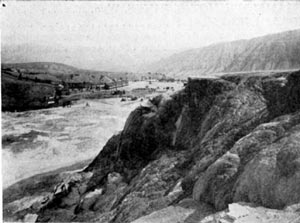 Terraces, Mammoth Hot Springs |
|||
|
2009 Ar.
|
Grand Canyon Hotel, Wyo. Luncheon, dinner and lodging at hotel. |
11.30 AM | |
|
Monday, September 13
Breakfast at hotel. |
|||
|
Lv.
|
Grand Canyon Hotel, Wyo. Leaving the wonders of the Grand Canyon behind, the stages begin the last lap of the journey through the Park. Skirting the foot of Mt. Washburn over a picturesque section of road, Norris Basin soon comes into view and a stop is made here for luncheon. |
8.15 AM | |
|
2021 Ar.
|
Norris, Wyo. Luncheon at hotel. |
10.30 AM | |
|
Lv.
|
Norris, Wyo. | 12.00 NN | |
|
2041 Ar.
|
Mammoth Hot Springs, Wyo. Arriving at Mammoth Hot Springs, there is ample time to inspect these marvels of beauty. The springs rise in terraces of various heights and widths. The overhanging bowls, adorned with delicate fretwork of a hundred hues in chalk-like tracery, hold van-colored waters that are startling in their brilliancy: Red, pink, black, canary, green, saffron, blue, chocolate, and all their intermediate gradations are found here. Dinner at Hotel. |
3.15 PM | |
|
Lv.
|
Mammoth Hot Springs, Wyo. | 6.15 PM | |
|
2046 Ar.
|
Gardiner, Mont. Here the party will bid farewell to the stages and the interesting drivers who have taken them through the wonders of the park. Northern Pacific Railway |
7.00 PM | |
|
Lv.
|
Gardiner, Mont. Resuming the Special Train at Gardiner, the party travel during the night down the winding valley of the Yellowstone for about four hundred miles, leaving it in the early morning to cross the plains of Montana and South Dakota. |
8.00 PM | |
|
Tuesday, September 14
Breakfast, luncheon and dinner in dining car. |
|||
| Shortly after leaving Glendive, near Medora station, one passes through Pyramid Park, where Nature has carved out of the splendidly-colored rock an army of spires, bluffs, hills, butte and castle-like cliffs. | |||
|
2657 Ar.
|
Mandan, N.D. (Mountain Time) | 2.30 PM | |
|
Lv.
|
Mandan, N.D. (Central Time) Passing thence through the country made memorable by the Custer campaign against the Indians which led to the Custer Massacre on the Little Big Horn, in 1876, and across the valleys of the Missouri, Skyene, James and Red River of the North, the party reach St. Paul early in the morning. |
3.35 PM | |
|
Wednesday, September 11
Breakfast, luncheon and dinner in dining car. |
|||
|
3108 Ar.
|
St. Paul, Minn. Chicago, Milwaukee & St. Paul Railway |
5.00 AM | |
|
Lv.
|
St. Paul, Minn. Leaving St, Paul without stop for sight-seeing, a run down the picturesque bank of the Mississippi and across the State of Wisconsin with its lakes and winding rivers to Lake Michigan at Milwaukee; thence along the lake shore, brings the party to Chicago. |
5.30 AM | |
|
3521 Ar.
|
Chicago, Ill. Pennsylvania Lines |
5.00 PM | |
|
Lv.
|
Chicago, Ill. | 5.25 PM | |
|
Thursday, September 16
Breakfast and luncheon in dining car. |
|||
|
3990 Ar.
|
Pittsburgh, Pa. (Central Time) Pennsylvania Railroad |
4.25 AM | |
|
Lv.
|
Pittsburgh, Pa. (Eastern Time) | 5.32 AM | |
|
4103 Ar.
|
Altoona, Pa. | 8.20 AM | |
|
Lv.
|
Altoona, Pa. | 8.25 AM | |
|
4235 Ar.
|
Harrisburg, Pa. | 11.20 AM | |
|
Lv.
|
Harrisburg, Pa. | 11.30 AM | |
|
4339 Ar.
|
Philadelphia, Pa. (Broad Street Station) | 2.00 PM | |
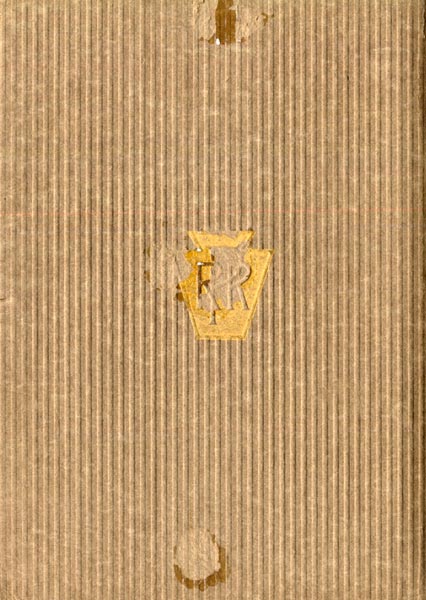 |
|||
|
|
|||